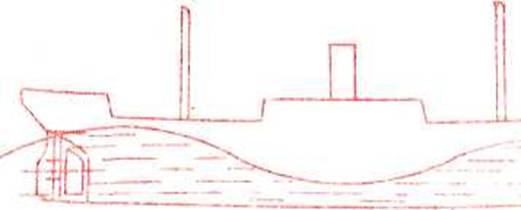Question
When a ship, due to misadventure, rests
on a hard bottom, what effect may this produce on the hull of the vessel?
What precaution should be taken by an
Engineer when the ship is afloat again?
When in dry dock state which parts should be
carefully examined? What is meant by a hogging stress, by a sagging stress?
Is hogging and sagging likely to take place
when the ship is afloat?
Answer.
The effect produced on the hull of a steamer which has
been ashore on a hard bottom will depend upon where the weight has been
supported, for example, say that

Fig. —Ship Hogging.
under the engine room, the resistance was
greatest, or in other words that the forward and after parts of the hull were
overhanging, then the engine room tanks and the frames, floors, etc., might be
set up and cause the engines to be forced out of line. We
might say the bottom of the ship was hogged in this case, while in the case of
the hull being supported at each end, the heavy weight at the centre might
cause the hull to sag. The precaution to be taken by an engineer when a ship is
likely to float is to find out if the tanks or double bottom are pierced
outside also if the tank tops are in a condition to enable the ship to proceed
to a dry dock for external and internal inspection. The precautions to be taken
when the ship is afloat will be to see that, all pumps are in good order, and
it might be well to see that the bilge injection is in good order in case it
may be necessary to use it if the main engine can be used for propulsion.

Fig. .—Ship Sagging.
When the ship is in dry dock a very thorough
examination will require to be made of the whole ship's bottom, both internally
and externally, and it may be well to mention that many pipes give way which may
need repair or at least testing.
When in a heavy head sea a sagging stress is set up when a' ship is supported at each end by two separate waves as shown in Fig. The condition being similar to a beam supported at the ends and loaded with a distributed load, not necessarily uniform. Fig. shows a hogging stress, the wave being under the centre of the ship.